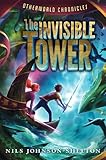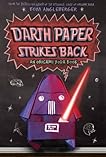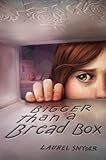Arthur “Artie” Kingfisher — twelve, rail thin, and not nearly tan enough for a kid in July — had just finished slaying Caladirth, a female green dragon with sharpened rubies for teeth and curved golden spikes for horns.

The Invisible Tower by Nils Johnson-Shelton
My rating: 2 of 5 stars
Synopsis:
Artie Kingfisher is a pretty average kid. He likes Mountain Dew and video games. He has a close relationship with his older sister, Kay, and their dad, Kynder. (Since he was eight years old, when he learned that he was adopted, Artie has called his father by his first name.) As Nitwit the Gray, he slays dragons and finds treasure in a game called Otherworld, but he knows wizards and magic only exist in fantasy. Or do they? Searching for a last-minute replacement game controller for Kay, Artie visits a store called the Invisible Tower, where he learns his own unbelievable true story: he is King Arthur, and he must journey to the real Otherworld to retrieve Excalibur and complete a quest that just might save the world.
Review:
This modern-day retelling of Arthurian legend features smart, sassy middle-schoolers tackling quests worthy of the Knights of the Round Table. The concept is good, which makes the execution all the more disappointing. Other than Artie and, to a lesser extent, Kay and Merlin, the characters are flat and lifeless. Because the situations are so bizarre – as even Artie notes – it should take more than a bit of hand-waving to get the characters to cooperate. The writing is clunky, with a heavy dependence on flat-out telling rather than showing. Things happen “suddenly”: while describing his first encounter at the Invisible Tower to Kay, Artie “couldn’t explain why it all made sense, but suddenly it did.” During their trip to the Lake to claim Excalibur, “[t]he sky suddenly got much darker”, a few short paragraphs later, “[t]he flock of birds suddenly dispersed”, a few pages after that, “suddenly [Artie] found two swords pointing straight up at the sky”, and once he holds the sword in his hand, Artie “suddenly knew some Welsh and a fair amount of Latin.” (Emphasis mine.)
There are many versions of the Arthurian saga available for young readers, from White’s classic The Once and Future King to Cammuso’s hilarious Knights of the Lunch Table. The standards are high. Otherworld never quite measures up.
On shelves January 3, 2012.
Final Word:
This modern-day middle-schooler King Arthur and his Knights are appealing in concept but fall disappointingly short of their potential.
Source:
e-ARC via NetGalley, provided by the publisher by request








